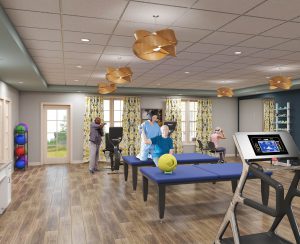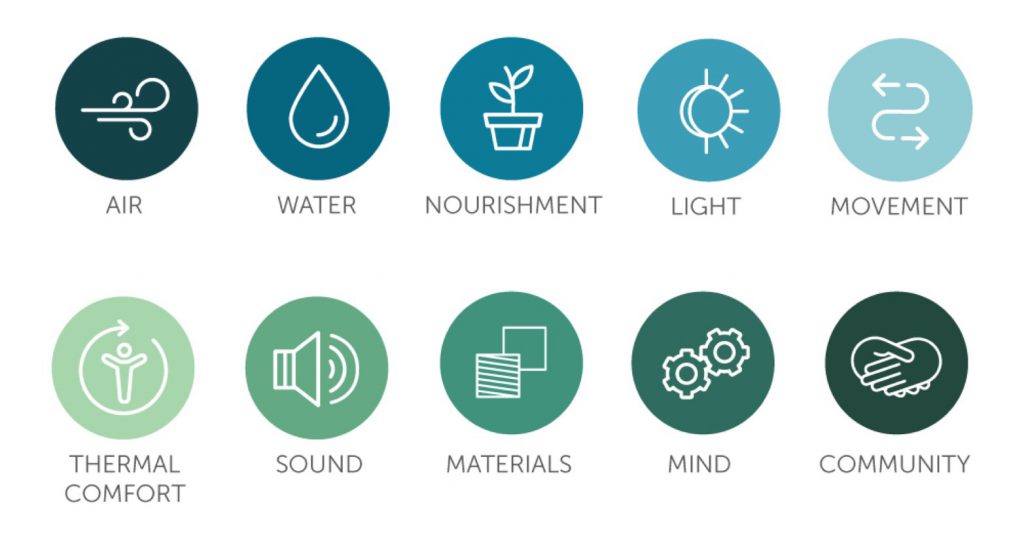Here at Meyer, the rapid spread of COVID-19 has caused us to reevaluate how we approach senior living design, and what it might mean to design for a world that will never be quite the same, especially in senior living communities across the country. The coronavirus pandemic has unleashed fundamental change throughout the world as everyone comes to terms with this new, unprecedented reality. As design professionals, Meyer’s Senior Living Studio has researched and explored how design will change and affect senior living communities in the immediate future and in the long term. Readiness Design is awareness, applications and tools for senior living developers, operators and owners to consider in order to combat the spread of COVID-19 or other potential outbreaks while maintaining a safer and healthier community.
Wellness
Wellness has been a buzzword in senior living for some time, and some providers believe it is replacing “care” as the driving concept for community operations. Residents are not only living longer but are remaining more healthy and active than previous generations. Fostering wellness in a community can take many shapes but as it relates to design, there is a new guideline called The WELL Building Standard that developers and operators may want to consider in their communities.



![]()
The WELL Building Standard (WELL) is the leading global rating system, improving the health and wellness of building occupants through better design, operations, and organizational policies. With over 350 million certified SF accumulated since its introduction in late 2014, this evidence-based process highlights the benefit of investing in a building that promotes health and well-being. Portions of WELL focus on construction materials or systems, which overlap with the Leadership in Energy and Environmental Design (LEED) rating system, such as indoor air quality, interior lighting or thermal comfort, however, where WELL outshines LEED is in the human impact its operational concepts and features can have on the built environment. As we look at senior living communities in a post pandemic world and measures that make sense to keep residents, staff and families as safe and healthy as possible, there are concepts within WELL that senior living communities should consider, including the following:
- Outline a schedule of sanitization and disinfection of high touch surfaces to help reduce exposure to pathogens, allergens and harming cleaning chemicals.
- Set daily cleaning protocols for water dispensers to promote safe hydration.
- Provide accessible and sanitary hand washing facilities,including sealed liquid soap cartridges, paper towel dispensers in lieu of air dryers and adequate sink sizes.
One WELL concept that shows extreme value in a post-COVID world is the Mind Concept. The vital role mental health plays in overall health has become increasingly undeniable as people attempt to navigate the “new normal” and the mental stresses associated with that. Developing spaces that support a healthy mental state can have significant psychological and physical benefits. WELL places emphasis on this in a few different ways:
- Access to therapies or volunteer opportunities that help promote relaxation and address mental or emotional trauma healing through experiences such as volunteering or social cohesion.
- Outlines healthy sleep habits, which is essential to good health and to maintain sustained mental and physical performance.
- Work/life balance and self-care through policies that help ensure that employees are able to take the necessary time off for self-care and balance their work and personal lives in a health manner.
- Bring awareness of individual biomarkers associated with health and wellness with self-monitoring devices.
- Encourage biophilia, which is the idea that humans have an affinity towards the natural world, into the design of spaces through lighting, patterns, natural plants or gardens. Research indicates that the experience of nature or nature-derived patterns can improve experience, mood and happiness.

About The Well Building Standard
The WELL Building Standard, founded by the International WELL Building Institute, is a performance based system for measuring, certifying and monitoring features of the built environment that impact human health and well-being. The first protocol of its kind, the WELL Building Standard identifies conditions that, when holistically integrated into building interiors, enhance occupant well- being. This system focuses on seven categories: air, water, nourishment, light, fitness, comfort and mind. 90% of our time is spent indoors and the WELL Building Standard uses design elements to unlock human potential by creating a design to increase healthy behaviors. It addresses how buildings will impact and enhance residents’ social, emotional and physical well-being while giving us an opportunity to create happy and healthier living environments for seniors.
The four pillars of the WELL Building Standard are:
- Prevention
- Preparedness
- Resilience
- Recovery
The WELL Building Standard (V2) concepts are further simplified by categorizing itself into 10 key principals reflected in the below chart, all focused on human health and wellbeing, both physical and mental.

For more insights from our Senior Living Studio regarding the WELL Building Standard, view the presentation given by Principal George Wilson, and Project Manager Allie Thompson at Leading Age PA in 2019.
![]()